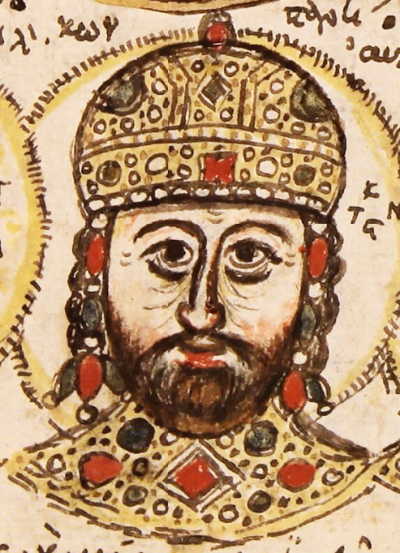Zo Porphyrogenita (Medieval Greek: Medieval Greek: [zoi] "life"; c. 978 1050) was Byzantine Empress from 11 November 1028 until her death in 1050, briefly ruling in her own right from April to June 1042, alongside her sister Theodora Porphyrogenita.
Zo was born when her father Constantine was nominal co-emperor to his brother, Basil II. Basil died in 1025 when Zo was 47. Her father ascended the Byzantine throne as Constantine VIII. As he had no sons, Constantine hoped to continue the dynasty by marrying off one of his daughters. Zo, aged 50, was married to Romanos Argyros. They took the throne the next day on her father's death.
The marriage of Zo and Romanos III was troubled, and Romanos was found dead in his bath in 1034. His death has been variously attributed to Zo, her young lover, or both. They were married on the same day as the supposed murder, and he was crowned Emperor Michael IV on the following day. In 1041, Zo was persuaded to adopt her dying husband's nephew, Michael Kalaphates.
Once Michael V became emperor, he promptly exiled Zo. This action sparked a popular revolt which dethroned him and installed Zo and her sister Theodora as joint empresses. After a two-month joint reign, Zo married a former lover who was installed as Constantine IX, transferring power to him. However, she continued to rule the empire as its heir and as the Byzantine empress. Eight years later, Zo died aged 72. Her reign saw the decline of the Roman army, and the first incursions by the Turks into eastern Anatolia.
This is a list of the Byzantine emperors from the foundation of Constantinople in 330 AD, which marks the conventional start of the Byzantine Empire (or the Eastern Roman Empire), to its fall to the Ottoman Empire in 1453 AD. Only the emperors who were recognized as legitimate rulers and exercised sovereign authority are included, to the exclusion of junior co-emperors (symbasileis) who never attained the status of sole or senior ruler, as well as of the various usurpers or rebels who claimed the imperial title.
The following list starts with Constantine the Great, the first Christian emperor, who rebuilt the city of Byzantium as an imperial capital, Constantinople, and who was regarded by the later emperors as the model ruler. It was under Constantine that the major characteristics of what is considered the Byzantine state emerged: a Roman polity centered at Constantinople and culturally dominated by the Greek East, with Christianity as the state religion.
The Byzantine Empire was the direct legal continuation of the eastern half of the Roman Empire following the division of the Roman Empire in 395. Emperors listed below up to Theodosius I in 395 were sole or joint rulers of the entire Roman Empire. The Western Roman Empire continued until 476. Byzantine emperors considered themselves to be rightful Roman emperors in direct succession from Augustus; the term "Byzantine" was coined by Western historiography only in the 16th century. The use of the title "Roman Emperor" by those ruling from Constantinople was not contested until after the Papal coronation of the Frankish Charlemagne as Holy Roman Emperor (25 December 800), done partly in response to the Byzantine coronation of Empress Irene, whose claim, as a woman, was not recognized by Pope Leo III.
In practice, according to the Hellenistic political system, the Byzantine emperor had been given total power through God to shape the state and its subjects, he was the last authority and legislator of the empire and all his work was in imitation of the sacred kingdom of God, also according to the Christian principles,he was the ultimate benefecator and protector of his people.

 English
English  español
español  français
français  português
português  русский
русский  العربية
العربية  简体中文
简体中文 
